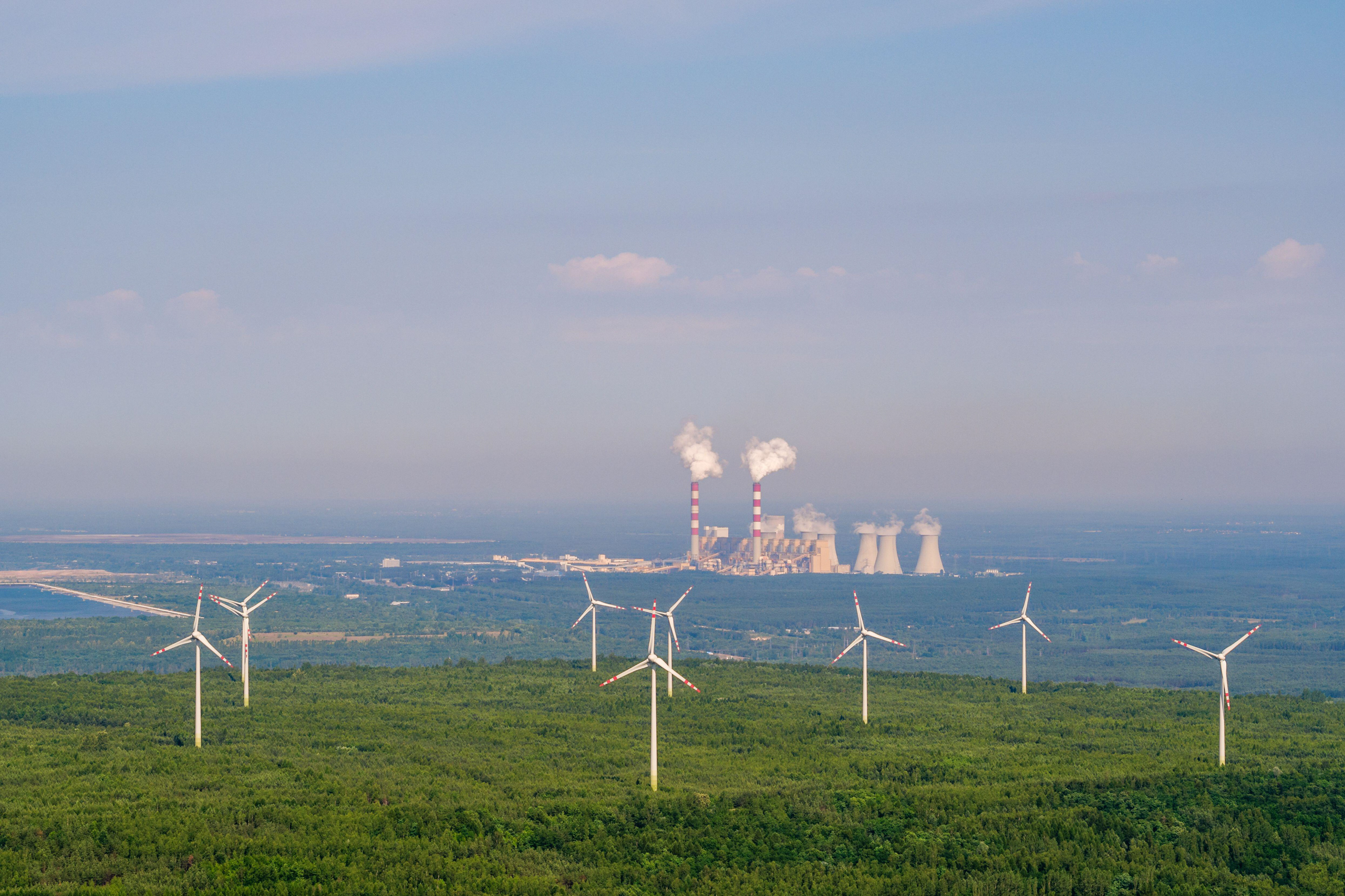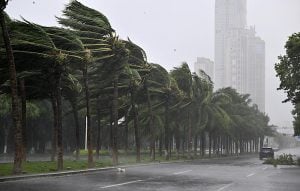In the EU, coal consumption rebounded in 2021 and 2022 as the economy recovered from the Covid-19 pandemic and an energy crisis escalated by Russia’s invasion of Ukraine prompted some countries to fire up coal power plants. In China, the media and public began to question Europe’s climate commitments.
But gas and coal use across the EU fell significantly in the second half of 2022, a Dialogue Earth analysis showed. Coal burning continued to decline in 2023, with coal-power generation hitting new lows, dropping 26% in a year to account for only 12% of the bloc’s electricity mix, according to energy think-tank Ember.
The EU has long been a leader in global climate governance. Its European Green Deal, published in late 2019, aimed to bring about “climate neutrality” by 2050, meaning net zero emissions of all greenhouse gases, not just CO2. In February of this year, the European Commission set an intermediate goal on that pathway – to reduce emissions by at least 90% by 2040, against a 1990 baseline. This would mean coal being “almost completely phased out” by 2040, according to an impact assessment report.
Pieter de Pous, who leads the Coal to Clean Programme at UK-based think-tank E3G, said Germany and Poland’s continued efforts are particularly important when it comes to the EU targets because despite falls in coal power generation in both countries in 2023, the two still account for 71% of the bloc’s coal generation.
Experts interviewed by Dialogue Earth believe Europe’s two largest coal consumers are accelerating the deployment of renewables to reduce their reliance on coal, but still face challenges around economic development and ensuring a just transition.
Could Germany phase out coal by 2030 rather than 2038?
Germany’s carbon emissions have been in general decline since 1979. Last year, they reached their lowest levels since the 1950s, with coal-power generation dropping by a quarter compared to 2022, from 180 gigawatts to 135 gigawatts, and coal’s share of the energy mix down to 26.8%, Ember found.
In January 2020, Germany passed a law requiring coal-fired power stations to be completely phased out by 2038, and published a detailed timetable. The government also committed to ending nuclear-power generation within two years, leading to concerns over power shortages.
When the 2022 energy crisis led to shortages of natural gas, the shutdown of the last three nuclear power plants had to be delayed; they were finally wound down in April last year. But fears that coal generation would pick up the slack proved unfounded, with fossil-fuel generation falling at the same time.
So Germany was able to cut coal generation while shutting down nuclear power and weathering natural gas shortages. This achievement was, at least in part, thanks to a rapid expansion of renewables.
Reforms designed to speed up the energy transition were announced in 2022. These included faster planning and approvals processes for renewables, and a requirement for 2% of all land to be reserved for wind power by 2032.
In 2023, Germany for the first time generated more than half of its power from renewable sources (excluding nuclear), Ember data shows. Last year also saw wind power overtake coal as the country’s largest single source of power, at 27.2% of the mix. The data also shows that together, wind and solar power accounted for 39% of all power generated, three times the global average of 13%.
However, a fall in electricity demand from industry, which saw reduced output last year, also helped cut emissions. Some are therefore worried about the relationship between economic performance and emissions. Agora Energiewende, a German think-tank, calculated that only 15% of Germany’s 2023 carbon cuts were permanent in nature, that is, achieved by adding new renewable energy, boosting energy efficiency or switching to lower-carbon fuels. Half of the cuts came from falling power demand and other short-term impacts; Reuters has reported a 5.3% drop in load on public power networks in 2023, reflecting that drop in demand. Germany’s economic slowdown has a range of causes including the war in Ukraine, high interests rates and deficits in skilled labour. When the expected recovery from these issues occurs, some emissions reductions gains are likely to be lost, Agora warns.
De Pous says the German government has set ambitious targets related to renewables, such as for at least 15 million electric vehicles to be on the roads by 2030. The associated growth in power demand has been factored into planning for renewable-energy construction, he adds. The question is, can Germany keep on expanding renewables to meet post-coal power demand?
The government seems confident. In fact, action at the state level indicates that the coal power shutdown may indeed come earlier. In late 2022, North Rhine-Westphalia – a centre for coal mining and heavy industry in the west of Germany – announced that coal generation would be phased out by 2030. States in the east of the country are making similar noises.
“Of course, Germany still has a lot of work to do,” said de Pous. “As in most countries rolling out renewable energy, the big task is construction and digitalisation of the power grid. Alongside that, Germany is also developing flexible energy tech, such as hydrogen power. I’m cautiously optimistic that Germany is on the right track with its energy transition. If the government’s renewable-energy plans come to fruition, a 2030 coal phase-out is feasible.”
Poland, an emerging decarbonisation ‘leader’?
Last year was a record-breaking one for Poland too. The country increased its wind and solar power generation by 7 terawatt hours, with their share of the energy mix up from 16% to 21%. Coal generation, meanwhile, fell by 22 terawatt hours, with its share of the energy mix dropping from 70% to 61%.
But unlike Germany, Poland’s annual emissions have remained steady over the last 25 years or so. However, a Polish politician speaking off the record told Dialogue Earth that while Poland’s emissions look high, the economy grew 2.5 times between 2000 and 2020, while emissions held steady. In other words, carbon intensity – meaning emissions per unit of GDP – more than halved. “That means that Poland, one of the world’s fastest growing economies, is already undergoing a sustained transition and has, for 25 years, been a leader on decarbonisation,” he said.
Poland’s journey away from coal can be traced back three decades. Between 1990 and 2020, output of hard coal, or anthracite, dropped 63%, while mining sector jobs fell 80%, from 390,000 to 80,000. However, this was an inevitable outcome of economic trends and the switch from a planned to a market economy, rather than a deliberate energy transition strategy by government, according to Resources for the Future, a US-based research institute.
Sometimes, Poland’s energy transition seems like a silent revolutionAleksander Śniegocki, CEO of the Reform Institute, a Polish think-tank
Poland is now making plans for decarbonisation, but it is more reliant on coal than Germany and so faces bigger challenges. In 2020, the government and union representatives agreed on an end to coal mining by 2049. The deal gave miners the right to transfer from closed mines to those still operating, or to get an early retirement package of 80% of their salaries.
The government also sought EU permission to provide state aid “for financing the current production, in order to ensure the stability of the hard-coal mining companies”. The EU regulates state aid provided by its member states, and experts think it unlikely that Poland will be allowed to keep funding coal mining.
Aleksander Śniegocki, CEO of the Reform Institute, a Polish think-tank, told Dialogue Earth that it remains to be seen how the new administration, which came to power in December, will manage that commitment, but it’s clear that the government cannot keep supporting loss-making mines. Western Europe once had many coal mines too, but at a certain point, the mining stops making economic sense, Śniegocki said.
Seeking to secure power supply security following the energy crisis, in October 2023 the EU suspended until the end of 2028 a requirement for power stations to stay within certain CO2 emissions limits in order to qualify for state aid. That effectively allowed member states to subsidise coal- and gas-power generation. In March this year, Poland’s top energy-security official told Reuters the country would need the suspension extended beyond 2028, until its first nuclear power plant comes online next decade.
Under the EU’s Emissions Trading System (ETS), certain industries must keep their CO2 emissions within a quota or buy additional allowances. De Pous said that, like Germany, Poland will speed up its coal phase-out in response to the tightening of ETS quotas as well as to the economic attractiveness of renewables. But unlike Germany, Poland is putting its hopes in new nuclear power stations. This is risky as nuclear power construction can be slow and expensive. In such a scenario the country may be left no choice but to burn coal and natural gas to bridge the gap, which would inevitably slow the energy transition, de Pous added.
Justice and efficiency
In 2021, Poland approved an energy policy framework running up to 2040. Known as PEP2040, the framework was roundly criticised for its lack of ambition. For example, its target to install 10-16 gigawatts of solar power by 2040 was met just two years later. And last year, renewables accounted for 27% of Poland’s energy mix – already approaching the 2030 target of 32%.
Śniegocki points out that, unlike Germany, Poland has no energy-transition roadmap or methodical top-down planning and implementation. The government’s thinking seems to be that an active approach, with forward planning and targets for an ambitious roll-out of renewables, would be a clear signal that demand for coal is going to fall. Such a communication would make the government unpopular with the mining unions. “Sometimes, Poland’s energy transition seems like a silent revolution,” he said.
After all, Poland is one of the EU’s fastest growing market for solar power. In 2018, heat pumps had 10% of the heating installation market. By 2023 that share had risen to 40%. And the country is set to become a major player in offshore wind, with a target of at least 3.4 gigawatts of generating capacity by 2030.
The Polish politician Dialogue Earth spoke to said the new administration is expected to boost ambition for both offshore wind and nuclear power. The closure of mines, he stressed, won’t just result in miners losing their jobs. There will also be grave consequences for their families and communities. Just transition policies need to be in place for them, he said, as well as solutions to ensure energy security. “It’s a sustained process, and we aren’t going to give up,” he said.
Ensuring a just transition for workers and communities reliant on the coal industry, while keeping the lights on in homes and factories, is a challenge for all decarbonising countries, not just Germany and Poland, he said.
In Germany, the far-right Alternative for Deutschland (AfD) party, which is opposed to a coal phase-out, garnered strong support in the east of the country in recent European elections. Some worry its influence will reduce the government’s climate ambition. In 2020, EUR 40 billion was promised in structural funding to reduce the impact of job losses, but eastern state leaders have again warned that ensuring a just transition will be key in keeping voters away from extremist parties.
In three eastern state elections in early September, the AfD received the most votes in Thuringia and came a close second in neighbouring Saxony. Reflecting on these results, de Pous told Dialogue Earth: “An earlier coal phase out in eastern Germany is just as likely to happen following these election results as before,” but with state government intervention less likely to play a part. The earlier phase out is now more likely to be “entirely driven by market forces,” he said.
De Pous believes that a just transition and industrial competitiveness will in fact be best achieved by speeding up renewable-energy development, and that this process should not be slowed by a minority seeking to keep their jobs a little longer. “In Europe, the debate about a just transition has often become instrumentalised,” he said. “We’ve already wasted a lot of time, which is preventing more people from enjoying the social and economic benefits of a transition to sustainable energy.”









